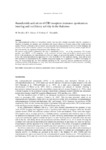Anandamide activation of CB1 receptors increases spontaneous bursting and oscillatory activity in the thalamus

Ver/
Use este enlace para citar
http://hdl.handle.net/2183/14637Coleccións
- GI-NEURO - Artigos [165]
- INIBIC-NEURO - Artigos [48]
Metadatos
Mostrar o rexistro completo do ítemTítulo
Anandamide activation of CB1 receptors increases spontaneous bursting and oscillatory activity in the thalamusData
2014-02-05Cita bibliográfica
Dasilva M, Grieve KL, Cudeiro J, Rivadulla C. Anandamide activation of CB1 receptors increases spontaneous bursting and oscillatory activity in the thalamus. Neurosci. 2014;265:72-82
Resumo
[Abstract] The endocannabinoid system is a modulatory system that has been strongly associated with the regulation of functions as learning and memory, pain perception and sensory physiology in many areas of the central nervous system. However, although a role in sensory processing has been demonstrated at the level of the thalamus, the influence of the endocannabinoid system on thalamic rhythms and oscillations has been less studied, despite the fact that such activities are significant characteristics of the thalamic state.
The present work aimed to characterize the role of anandamide (AEA) – one of the endogenous CB1 receptor agonists – and AM251 – a CB1 antagonist – in the modulation of burst firing and oscillatory activity present in the dLGN of the anesthetized rat. Administration of AEA (0.5 mg/kg iv) increased the number of bursts in the majority of the cells tested and induced the appearance of a slow delta-like (1.5 Hz) oscillatory activity. These effects were CB1-mediated, as demonstrated by the complete antagonism during the co-application of AM251 (0.5 mg/kg iv). Thus, by demonstrating that the AEA-mediated activation of CB1 receptors increases spontaneous bursting and oscillatory activity in the thalamus our study infers that endocannabinoids could have a role in processes controlling the sleep–wake cycle and level of arousal.
Palabras chave
Endocannabinoids
Thalamus
Anandamide
Burst
Oscillations
Sleep
Thalamus
Anandamide
Burst
Oscillations
Sleep





